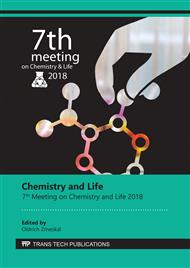[1]
Naffakh M, Dumon M, Dupuy J et al., Cure kinetics of an epoxy/liquid aromatic diamine modified with poly(ether imide), J. Appl. Polym. Sci. 96(3) (2005) 660–672.
DOI: 10.1002/app.21495
Google Scholar
[2]
Kondyurin A, Komar LA, Svistkov AL, Combinatory model of curing process in epoxy composite, Composites Part B: Engineering 43(2) (2012) 616–620.
DOI: 10.1016/j.compositesb.2011.11.019
Google Scholar
[3]
Farquharson S, Carignan J, Khitrov V et al. (eds), Development of a phase diagram to control composite manufacturing using Raman spectroscopy, International Society for Optics and Photonics (2004).
Google Scholar
[4]
Hardis R, Jessop JL, Peters FE et al., Cure kinetics characterization and monitoring of an epoxy resin using DSC, Raman spectroscopy, and DEA, Composites Part A: Applied Science and Manufacturing 49 (2013) 100–108.
DOI: 10.1016/j.compositesa.2013.01.021
Google Scholar
[5]
Stark W, Jaunich, M, JMcHugh J, Carbon-fibre epoxy prepreg (CFC) curing in an autoclave analogue process controlled by Dynamic Mechanical Analysis (DMA), Polymer Testing 32(8) (2013)1487–1494.
DOI: 10.1016/j.polymertesting.2013.09.014
Google Scholar
[6]
Youngs M, Wartewig S, Lellinger D, The curing of epoxy-resins as studied by various methods, Polymer 35 (1994) 5269-5278. resin system, JOURNAL OF APPLIED POLYMER SCIENCE 102(4) (2006) 3168–3180.
DOI: 10.1016/0032-3861(94)90479-0
Google Scholar
[7]
Merad L, Cochez M, Margueron S et al., In-situ monitoring of the curing of epoxy resins by Raman spectroscopy, Polymer Testing 28(1) (2009) 42–45.
DOI: 10.1016/j.polymertesting.2008.10.006
Google Scholar
[8]
Vašková, H, and Křesálek V., Raman spectroscopy of epoxy resin crosslinking, 13th WSEAS International Conference on Automation Control, Modeling & Simulation (ACMOS'11), Lanzarote, Canary Islands, Spain. (2011).
Google Scholar
[9]
Malkin AY, Kulichikhin SG, Kerber ML et al., Rheokinetics of curing of epoxy resins near the glass transition, Polymer Engineering & Science 37(8) (1997) 1322–1330.
DOI: 10.1002/pen.11778
Google Scholar
[10]
Liang G, Chandrashekhara K, Cure kinetics and rheology characterization of soy based epoxy.
Google Scholar
[11]
Kavanagh GM, Ross-Murphy, SB Rheological characterisation of polymer gels, Progress in Polymer Science 23(3) (1998) 533–562.
DOI: 10.1016/s0079-6700(97)00047-6
Google Scholar
[12]
Tung CM, Dynes PJ, Relationship between viscoelastic properties and gelation in thermosetting systems, J. Appl. Polym. Sci. 27(2) (1982) 569–574.
DOI: 10.1002/app.1982.070270220
Google Scholar
[13]
Matějka L, Rheology of epoxy networks near the gel point, Polymer Bulletin 26(1) (1991) 109–116.
DOI: 10.1007/bf00299355
Google Scholar
[14]
Ivankovic M, Incarnato L, Kenny JM et al., Curing kinetics and chemorheology of epoxy/anhydride system, Journ APPLIED POLYMER SCIENCE 90(11) (2003) 3012–3019.
DOI: 10.1002/app.12976
Google Scholar
[15]
Ellis B, Chemistry and technology of epoxy resins, Springer, (1993).
Google Scholar
[16]
NEZ LNU, Taboada J, Fraga F et al., Kinetic Study and Time–Temperature–Transformation Cure Diagram for an Epoxy–Diamine System, JOURNAL OF APPLIED POLYMER SCIENCE 66 (1997) 1377–1388.
DOI: 10.1002/(sici)1097-4628(19971114)66:7<1377::aid-app16>3.0.co;2-#
Google Scholar
[17]
Turi E, Thermal characterization of polymeric materials, Elsevier (1981).
Google Scholar
[18]
Chai CK, Dixon NM, Gerrard DL et al., Rheo-Raman studies of polyethylene melts, Polymer 36(3) (1995) 661–663.
DOI: 10.1016/0032-3861(95)91578-u
Google Scholar
[19]
Chevrel M, Brun N, Hoppe S et al., In situ monitoring of acrylic acid polymerization in aqueous solution using rheo-Raman technique, Experimental investigation and theoretical modelling, Chemical Engineering Science 106 (2014) 242–252.
DOI: 10.1016/j.ces.2013.11.039
Google Scholar
[20]
Farquharson S, Smith W, Rose J et al., Correlations between molecular (Raman) and macroscopic (rheology) data for process monitoring of thermoset composite, JPAC (sm) Process Analytical Chemistry (2002) 45–53.
Google Scholar
[21]
Xu L, Fu JH, Schlup, JR, In situ near-infrared spectroscopic investigation of epoxy resin-aromatic amine cure mechanisms, Journal of the American Chemical Society 116(7) (1994) 2821–2826.
DOI: 10.1021/ja00086a015
Google Scholar
[22]
Ullah R, Zheng Y, Raman spectroscopy of Bisphenol A,, Journal of Molecular Structure 1108 (2016) 649–653.
DOI: 10.1016/j.molstruc.2015.12.060
Google Scholar


